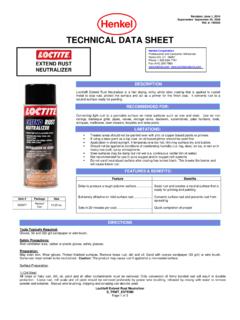Transcription of Safety Aspects of Signal Timing - Traffex Engineers
1 Safety Aspects OF Timing . TRAFFIC SIGNALS. Presented by Nazir Lalani Traffex Engineers Inc. Traffic Signal Timing and Control For Isolated Intersections Phase Numbering 1. Phase Diagram and Numbering System To encourage standardization a standard numbering system was developed for labeling movements at an intersection Left turns are odd numbered; 1,3,5,7. Through movements are even numbered: 2,4,6,8. Coordinated or Major Street phase are 1,2,5 and 6. NEMA and 170 controllers usually follow the same numbering scheme Phase Diagram Vehicle Detection 2.
2 Loops Vehicle Detection a. Magnetic Inductance loops are the most common form of vehicle detection b. They only last on an average of 7 years. c. The are easily damaged by pavement failure and construction projects d. When functioning properly they are very accurate 3. Magnetic Inductance Loop Detectors Loop Installation 1. 4. Traditional round detection loops in pavement Video Cameras 5. Digitally defined detection zones Video Detection Cannot be damaged like loops Costs have become comparable to loops Cameras are failing within five years Severe glare/shadow problems continue with some brands Some agencies have stopped using video 6.
3 Loops Digitally defined detection zones 7. Semi Actuated Operation Semi Actuated Minor street detection No major street detection Signal rests on major street when no vehicles on minor street Pushbuttons to cross major street only 8. Loops on side street only Semi actuated traffic Signal Semi Actuated Timing Minor street minimum green: 6 to 8 . Minor street extension: 2 per vehicle Minor street maximum extension: 30 . (Pedestrian phase time). Major street minimum green: 30 to 40 . Signal dwells green on major street unless there is a side street or left-turn phase call 9.
4 Fully Actuated Operation Fully Actuated Signals Presence detectors on minor street Advance detectors on major street 8 phase maximum Semi/full actuation based on maintenance costs 10. Left- Left-turn lane detectors Advance detectors 325 feet back Call detectors at the Xwalk Fully Actuated Timing Minor Street Minimum Green: 6 to 8 . Minor Street Extension: 2 per vehicle Minor Street Maximum : 30 (Pedestrian phase time). Major Street Minimum Green: 10 to 15 . Major Street Extension: 3-5 per vehicle depending on location of advance loops 11.
5 Advance Detector Placement Source: CA Supplement to the MUTCD. Volume Density Timing 12. Volume - Density Control The extension varies from an initial value, called the Time, to a final value, called the Min Gap. Passage Time, Gap. a. The extension is reduced from the passage time after a time equal to Time Before Reduction. b. The extension is reduced at a uniform rate over a time equal to the Time to Reduce until it reaches the Min Gap. Min Gap is often between 2 and 3 seconds. Should be long enough to prevent premature gap out, but short enough to prevent needlessly extending the green.
6 5-8 . every 1 . 1 . 2-3 . Volume density Timing 13. Phase Locking Magnetic Inductance Loop Detectors 14. Lock v. Non-Lock a. When set to locking, a phase will service an actuation that occurred and disappeared during the yellow or red. b. Intention is to make sure the Signal turns green for a waiting vehicle. c. Phase should be locked where left- left-turning vehicles ten to overshoot the left- left-turn lane detectors in a lane served by a protected left- left-turn phase. d. Another example would be where the side street loops are set back more than one vehicle length from the major street curb.
7 A single vehicle located in that area may be trapped . trapped until a second vehicle arrives Change Intervals for the Through Movements (Phases 2,4,6,8). 15. Vehicle Change Intervals (Yellow). Yellow interval is not for clearance a. Yellow is to warn drivers that red is about to appear. b. In most states, it is legal to enter on yellow, but not on red. c. MUTCD specifies 3 to 6 seconds, based on approach speed d. Can use formula for calculating the exact value of the interval Formula for Change Intervals The recommended formula for determining an appropriate change interval interval is: Y = t + V/(2a 2 Gg).
8 Where: Y = length of the yellow interval t = driver perception/reaction time, recommended at seconds. seconds. V = velocity of approaching vehicle in feet/second, recommended recommended that the 85 percentile Signal approach speed or the posted speed limit, limit, converted to feet/second, be used. a = vehicle deceleration rate, recommended as 10 feet per second2. g = acceleration due to gravity at 32 feet per second2. G = grade of the Signal approach in percent divided by 100 or 2 percent is A downhill grade results in a negative term term 16.
9 Yellow Change Interval For Level Terrain Source: CA Supplement to the MUTCD. All-red Clearance Interval a. Provides time for vehicles entering at end of Yellow Change Interval to clear before start of opposing green b. Red clearance intervals normally range from to seconds c. Some Engineers are opposed to All- All-red clearance intervals because it may encourage red light violations 17. All-red Clearance Interval Formula Used By Some Agencies R= W+V. S. Where: S = 85th percentile speed, (ft/s). W = Width of intersection from near side stop line to end of far side crosswalk, (ft).
10 V = Length of vehicle, (V = 15 ft). R = red clearance interval (s). All-red Clearance Intervals Used By Some Agencies 85th Red Clearance Interval, (seconds), for Width of Percent Intersection, (feet). ile speed, (mph). 40 60 80 100 120 140 160 180 200. 15 20 25 30 35 40 45 50 55 60 Note: Shaded intervals are > seconds and shall not be used. 18. 35 mph or 50 feet per second x 2 . 2 . = 100'. 100' of distance covered Traffic Signal control for one-lane traffic flow at construction site 19. Signal Timing for the Left-turn Movements (Phases 1,3,5,7).





